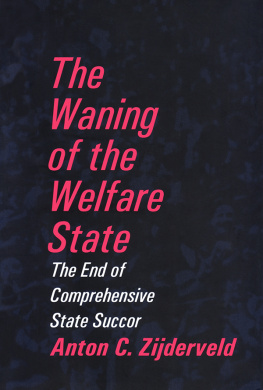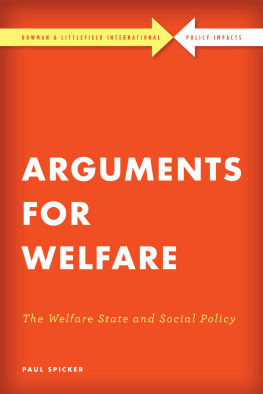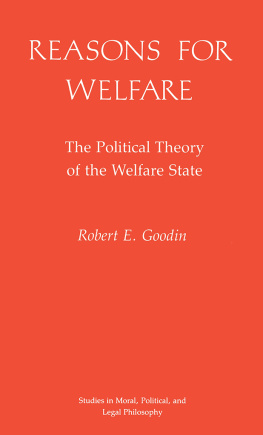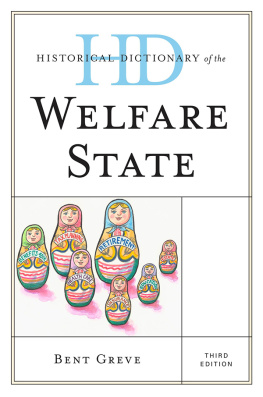First published 1999 by Transaction Publishers
Published 2017 by Routledge
2 Park Square, Milton Park, Abingdon, Oxon OX14 4RN
711 Third Avenue, New York, NY 10017, USA
Routledge is an imprint of the Taylor & Francis Group, an informa business
Copyright 1999 by Taylor & Francis.
All rights reserved. No part of this book may be reprinted or reproduced or utilised in any form or by any electronic, mechanical, or other means, now known or hereafter invented, including photocopying and recording, or in any information storage or retrieval system, without permission in writing from the publishers.
Notice:
Product or corporate names may be trademarks or registered trademarks, and are used only for identification and explanation without intent to infringe.
Library of Congress Catalog Number: 98-53726
Library of Congress Cataloging-in-Publication Data
Zijderveld, Anton C., 1937-
The waning of the welfare state : the end of comprehensive state succor / Anton C. Zijderveld.
p. cm.
Includes bibliographical references and index.
ISBN 1-56000-405-3 (alk. paper)
1. Welfare stateHistory. 2. Europe, WesternSocial policy. 3. DemocracyEurope, WesternHistory. 4. Civil societyEurope, WesternHistory. 5. SocialismEurope, WesternHistory. 6. ConservatismEurope, WesternHistory. 7. LiberalismEurope, WesternHistory. I. Boyle, Richard, 1955-. II. Lemaire, Donald. III. Series.
JC479.Z55 1999
361.65094dc21 98-53726
CIP
ISBN 13: 978-1-56000-405-9 (hbk)
The title of this book with its perhaps inexcusable yet to the author nonetheless enticing alliteration, is an obvious nod to Johan Huizingas famous study of the late Burgundian Middle Ages. It does however stand in need of a brief explanation. The title should not be misread. The main argument of the book is not that the welfare state will or should disappear. Waning is meant as a fundamental transformation that makes room for renewal and regeneration. In fact, ever since Elizabeth I and her Poor Law, Western societies have held the state responsible for the care of the needy, the vulnerable and the weak; for the cure of the sick and the succor of the disabled. Thus, some form of state which is responsible for the well-being and welfare of its citizens, is and remains endemic to a society which aspires to be civilized. The question is, however, how extensive and intensive such a welfare state should be. It is argued in this book that the comprehensive (i.e., intensive and extensive) welfare state which most Western European countries have erected after the Second World War, has been reduced in both scope and intensity ever since roughly 1980.
In most postbellum countries of Western Europe, in which, incidentally, in this book Great Britain is included, the welfare state has been extended and intensified in a spectacular manner. In fact, the notion of welfare was broadened into a complex mix of services covering not just health, education and welfare, but the arts, leisure, and above all social security in the working place as well. It is the argument of this book that this comprehensive and well-nigh oceanic welfare state, which at times even seemed to pretend to secure the happiness of its citizens, has waned ever since the 1980s. We are heading, both in Europe and the United States, towards a more sober, much more decentralized and deregulated welfare state which takes care of its proper core business, i.e., being a constitutional state that secures safety and order to its citizens and offers a shield to the vulnerable in society. This leaner, meaner welfare state should leave sufficient space for the market to develop and for civil society to prosper. As the close of the century draws near and the dawn of the new millennium approaches we are experiencing in a sense a sort of cultural Renaissance, as well as a socioeconomic and political Reformation.
The focus of the book is Europe, but it is believed that the European welfare state experience of the past four decades is of interest to American readers who should weigh the advantages and disadvantages of these experiences. They will, it is hoped, discover beyond the vast differences, some basic similarities of structure and development, through a comparison of welfare state experiences in America and Europe.
The various arguments in this book concerning the basic transformations of the comprehensive welfare state of the 1960s and 1970s, are based upon a rather simple theoretical model, explained in more detail in the last chapter, yet briefly outlined at the outset. It is the notion of a Democratic Triangle in which democracy, whatever this concept may contain and entail, is viewed as a system in which State, Market, and (Civil) Society are held in precious balance. If one of these components supersedes the other two, democracy is endangered. These three components of the Democratic Triangle also represent the three main political ideologies of democracy: social democracy, liberalism, and conservatism (or, in some European countries, Christian democracy).
When the welfare state grows ever more comprehensive, the increasingly centralized state will become enlarged at the expense of the market and civil society. This is, of course, what happened ad absurdum in communism but, albeit still in terms of (an often somewhat shaky) democracy, in many Western European societies as well. The 1960s and 1970s, the true heyday of the comprehensive welfare state in Western Europe, witnessed the predominance of the state at the expense of the market and civil society. Social democracy, often crudely labeled socialism, was the predominant ideology. The 1980s were the decade in which the market recaptured its position in the Democratic Triangle, often at the expense of both the state and civil society. It was the decade of liberalism, often erroneously held to be conservative. (Mrs. Thatcher and Mr. Reagan were in terms of socioeconomic policy true liberals, not conservatives!). The 1990s witness the recovery of civil society, which again runs the risk of being injurious to the position of the state and the market (as, for example, in communitarianism).
Ideologically, this is the decade of conservatism and a conservative view of the welfare state. However, the near future may well witness a fortuitous balance within the Democratic Triangle, and thus a basic coalition of social democracy, liberalism, and conservatism. This will be to the benefit of the state (i.e., to safety and order), to the market (i.e., to prosperity and economic participation), and to civil society (i.e., to social participation and meaningful interactions). Again, all of this will be discussed in more detail at the end of the book, but as it is the main focus of the arguments to follow, keep this in mind while reading the beginning chapters.
Portions of this book have appeared before in a Dutch publication which I wrote at the end of the 1970s, together with my colleague Hans P. Adriaansens of the University of Utrecht. I used only the chapters I myself authored but did much more than just translate them into English. A complete overhaul was necessary. Adriaansenss influences, however, were and still are considerable, particularly as far as horizontalism and verticalism as two structural principles are concerned. I am, however, responsible for the manner in which I incorporated these heuristically useful concepts in the present book.
I received valuable bibliographical assistance from Jacqueline Markvoort and Hennie Helmer, while Dick Houtman, senior research assistant at the Sociology Department of Erasmus University helped me by writing two extensive reviews of the relevant literature. I am grateful for these contributions but again remain solely responsible for their incorporation into the present arguments.











